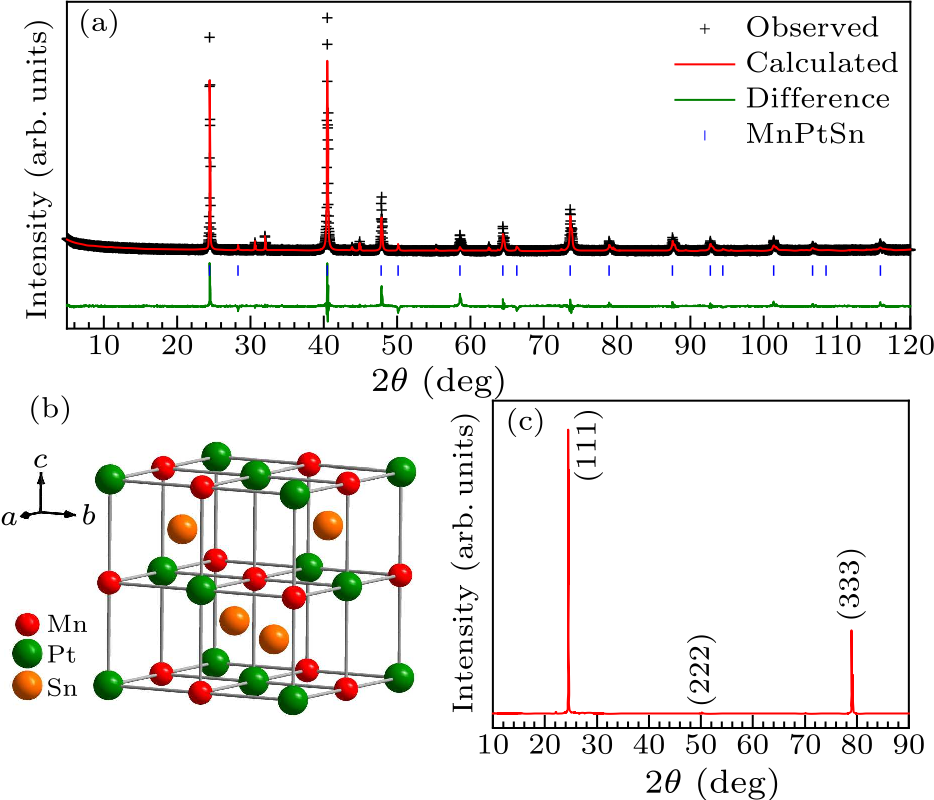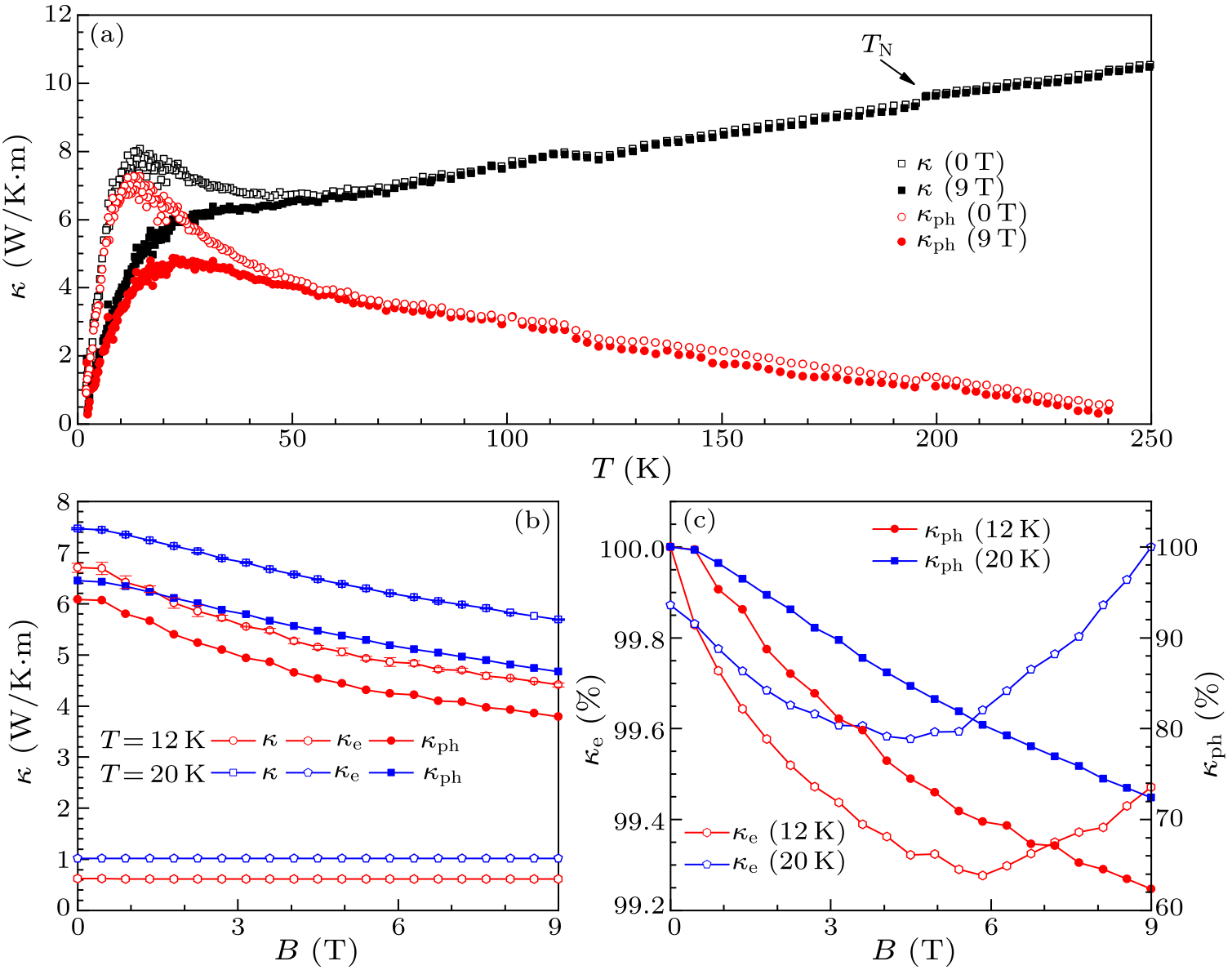
Fig. 1. (a) Powder XRD pattern and Rietveld refinement of ground MnPtSn single crystals. Vertical tickmarks denote Bragg reflections of the $F\bar{4}3m$ space group. (b) Crystal structure of MnPtSn. The red, green and orange balls represent Mn, Pt, Sn atoms, respectively. (c) XRD pattern of a MnPtSn single crystal.

Fig. 2. (a) Temperature dependence of magnetic susceptibility $\chi(T)$ for MnPtSn single crystal with ZFC and FC modes at $B= 0.1$ T and 9 T for $B \Vert [111]$. (b) Isothermal magnetization $M(B)$ as a function of magnetic field $B$ at various temperatures for $B \Vert [111]$. Inset: $M(B)$ loop from $-9$ to 9 T at 5 K.

Fig. 3. (a) Temperature dependence of longitudinal resistivity $\rho(T)$ at zero field. (b) Field dependence of magnetoresistance MR at various temperatures for $B \Vert [111]$. (c) Hall resistivity $\rho_{\rm H}(B)$ as a function of $B$ at various temperatures for $B \Vert [111]$. (d) Temperature dependence of Hall coefficient $R_{\rm H}(T)$ derived from $\rho_{\rm H}(B)$. Inset: temperature dependence of apparent carrier concentration $n_{\rm a}(T)$.

Fig. 4. (a) Temperature dependence of thermal conductivity $\kappa(T)$ at $B= 0$ T and 9 T. (b) Field dependence of $\kappa(B)$, electron thermal conductivity $\kappa_{\rm e}(B)$ and phonon thermal conductivity $\kappa_{\rm ph}(B)$ at various temperatures for $B \Vert [111]$. (c) Field dependence of normalized $\kappa_{\rm e}(B)$ and $\kappa_{\rm ph}(B)$ at various temperatures.
| [1] | Wolf S A, Awschalom D D, Buhrman R A, Daughton J M, von Molnár S, Roukes M L, Chtchelkanova A Y and Treger D M 2001 Science 294 1488 | Spintronics: A Spin-Based Electronics Vision for the Future
| [2] | Galanakis I and Dederichs P H 2005 Half-metallic Alloys: Fundamentals and Applications (Berlin: Springer-Verlag) p 1 |
| [3] | Katsnelson M I, Irkhin V Y, Chioncel L, Lichtenstein A I and de Groot R A 2008 Rev. Mod. Phys. 80 315 | Half-metallic ferromagnets: From band structure to many-body effects
| [4] | Hirohata A, Sagar J, Lari L, Fleet L R and Lazarov V K 2013 Appl. Phys. A 111 423 | Heusler-alloy films for spintronic devices
| [5] | Hirohata A and Takanashi K 2014 J. Phys. D 47 193001 | Future perspectives for spintronic devices
| [6] | Felser C, Wollmann L, Chadov S, Fecher G H and Parkin S S P 2015 APL Mater. 3 041518 | Basics and prospective of magnetic Heusler compounds
| [7] | Geldart D J W and Ganguly P 1970 Phys. Rev. B 1 3101 | Hyperfine Fields and Curie Temperatures of the Heusler Alloys MnAl, MnIn, and MnSn
| [8] | Podgornykh S M, Streltsov S V, Kazantsev V A and Shreder E I 2007 J. Magn. Magn. Mater. 311 530 | Heat capacity of Heusler alloys: Ferromagnetic Ni2MnSb, Ni2MnSn, NiMnSb and antiferromagnetic CuMnSb
| [9] | de Groot R A, Mueller F M, van Engen P G and Buschow K H J 1983 Phys. Rev. Lett. 50 2024 | New Class of Materials: Half-Metallic Ferromagnets
| [10] | Ishida S, Fujii S, Kashiwagi S and Asano S 1995 J. Phys. Soc. Jpn. 64 2152 | Search for Half-Metallic Compounds in Co 2 MnZ (Z=IIIb, IVb, Vb Element)
| [11] | Galanakis I, Dederichs P H and Papanikolaou N 2002 Phys. Rev. B 66 174429 | Slater-Pauling behavior and origin of the half-metallicity of the full-Heusler alloys
| [12] | Graf T, Felser C and Parkin S S P 2011 Prog. Solid State Chem. 39 1 | Simple rules for the understanding of Heusler compounds
| [13] | Jourdan M, Minár J, Braun J, Kronenberg A, Chadov S, Balke B, Gloskovskii A, Kolbe M, Elmers H J, Schönhense G, Ebert H, Felser C and Kläui M 2014 Nat. Commun. 5 3974 | Direct observation of half-metallicity in the Heusler compound Co2MnSi
| [14] | Jeong T, Weht R and Pickett W E 2005 Phys. Rev. B 71 184103 | Semimetallic antiferromagnetism in the half-Heusler compound CuMnSb
| [15] | Singh S, DSouza S W, Nayak J, Suard E, Chapon L, Senyshyn A, Petricek V, Skourski Y, Nicklas M, Felser C and Chadov S 2016 Nat. Commun. 7 12671 | Room-temperature tetragonal non-collinear Heusler antiferromagnet Pt2MnGa
| [16] | Canfield P C, Thompson J D, Beyermann W P, Lacerda A, Hundley M F, Peterson E, Fisk Z and Ott H R 1991 J. Appl. Phys. 70 5800 | Magnetism and heavy fermion‐like behavior in the RBiPt series
| [17] | Suzuki T, Chisnell R, Devarakonda A, Liu Y T, Feng W, Xiao D, Lynn J W and Checkelsky J G 2016 Nat. Phys. 12 1119 | Large anomalous Hall effect in a half-Heusler antiferromagnet
| [18] | Shekhar C, Kumar N, Grinenko V, Singh S, Sarkar R, Luetkens H, Wu S, Zhang Y, Komarek A C, Kampert E, Skourski Y, Wosnitza J, Schnelle W, McCollam A, Zeitler U, Kübler J, Yan B, Klauss H H, Parkin S S P and Felser C 2018 Proc. Natl. Acad. Sci. USA 115 9140 | Topological semimetal and Fermi-arc surface states in the electronic structure of pyrochlore iridates
| [19] | Singha R, Roy S, Pariari A, Satpati B and Mandal P 2019 Phys. Rev. B 99 035110 | Magnetotransport properties and giant anomalous Hall angle in the half-Heusler compound TbPtBi
| [20] | Otto M J, Feil H, van Woerden R A M, Wijngaard J, van der Valk P J, van Bruggen C F and Haas C 1987 J. Magn. Magn. Mater. 70 33 | Electronic structure and magnetic, electrical and optical properties of ferromagnetic Heusler alloys
| [21] | Li Y, Ding B, Wang X, Zhang H, Wang W and Liu Z 2018 Appl. Phys. Lett. 113 062406 | Large topological hall effect observed in tetragonal Mn 2 PtSn Heusler thin film
| [22] | Swekis P, Markou A, Kriegner D, Gayles J, Schlitz R, Schnelle W, Goennenwein S T B and Felser C 2019 Phys. Rev. Mater. 3 013001(R) | Topological Hall effect in thin films of
| [23] | Vir P, Gayles J, Sukhanov A S, Kumar N, Damay F, Sun Y, Kübler J, Shekhar C and Felser C 2019 Phys. Rev. B 99 140406(R) | Anisotropic topological Hall effect with real and momentum space Berry curvature in the antiskrymion-hosting Heusler compound
| [24] | Liu Z H, Burigu A, Zhang Y J, Jafri H M, Ma X Q, Liu E K, Wang W H and Wu G H 2018 Scr. Mater. 143 122 | Giant topological Hall effect in tetragonal Heusler alloy Mn 2 PtSn
| [25] | Buschow K H J, van Engen P G and Jongebreur R 1983 J. Magn. Magn. Mater. 38 1 | Magneto-optical properties of metallic ferromagnetic materials
| [26] | Slater J C 1964 J. Chem. Phys. 41 3199 | Atomic Radii in Crystals
| [27] | Kroder J, Manna K, Kriegner D, Sukhanov A S, Liu E K, Borrmann H, Hoser A, Gooth J, Schnelle W, Inosov D S, Fecher G H and Felser C 2019 Phys. Rev. B 99 174410 | Spin glass behavior in the disordered half-Heusler compound IrMnGa
| [28] | Simon E, Vida J G, Khmelevskyi S and Szunyogh L 2015 Phys. Rev. B 92 054438 | Magnetism of ordered and disordered full Heusler compounds
| [29] | Jeon B, Koteswararao B, Park C B, Shu G J, Riggs S C, Moon E G, Chung S B, Chou F C and Kim K H 2016 Sci. Rep. 6 36970 | Giant suppression of phononic heat transport in a quantum magnet BiCu2PO6
| [30] | Sharma P A, Ahn J S, Hur N, Park S, Kim S B, Lee S, Park J G, Guha S and Cheong S W 2004 Phys. Rev. Lett. 93 177202 | Thermal Conductivity of Geometrically Frustrated, Ferroelectric : Extraordinary Spin-Phonon Interactions
| [31] | Peacor S D, Cohn J L and Uher C 1991 Phys. Rev. B 43 8721 | Effect of magnetic field on thermal conductivity of single crystals